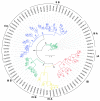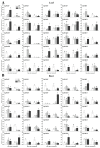Genome-Wide Identification and Characterization of the HAK Gene Family in Quinoa (Chenopodium quinoa Willd.) and Their Expression Profiles under Saline and Alkaline Conditions
- PMID: 37960103
- PMCID: PMC10650088
- DOI: 10.3390/plants12213747
Genome-Wide Identification and Characterization of the HAK Gene Family in Quinoa (Chenopodium quinoa Willd.) and Their Expression Profiles under Saline and Alkaline Conditions
Abstract
The high-affinity K+ transporter (HAK) family, the most prominent potassium transporter family in plants, which involves K+ transport, plays crucial roles in plant responses to abiotic stresses. However, the HAK gene family remains to be characterized in quinoa (Chenopodium quinoa Willd.). We explored HAKs in quinoa, identifying 30 members (CqHAK1-CqHAK30) in four clusters phylogenetically. Uneven distribution was observed across 18 chromosomes. Furthermore, we investigated the proteins' evolutionary relationships, physicochemical properties, conserved domains and motifs, gene structure, and cis-regulatory elements of the CqHAKs family members. Transcription data analysis showed that CqHAKs have diverse expression patterns among different tissues and in response to abiotic stresses, including drought, heat, low phosphorus, and salt. The expressional changes of CqHAKs in roots were more sensitive in response to abiotic stress than that in shoot apices. Quantitative RT-PCR analysis revealed that under high saline condition, CqHAK1, CqHAK13, CqHAK19, and CqHAK20 were dramatically induced in leaves; under alkaline condition, CqHAK1, CqHAK13, CqHAK19, and CqHAK20 were dramatically induced in leaves, and CqHAK6, CqHAK9, CqHAK13, CqHAK23, and CqHAK29 were significantly induced in roots. Our results establish a foundation for further investigation of the functions of HAKs in quinoa. It is the first study to identify the HAK gene family in quinoa, which provides potential targets for further functional study and contributes to improving the salt and alkali tolerance in quinoa.
Keywords: HAK gene family; alkali stress; expression profile; quinoa; salt stress.
Conflict of interest statement
The authors declare no conflict of interest.
Figures






Similar articles
-
Comprehensive Analysis of the NHX Gene Family and Its Regulation Under Salt and Drought Stress in Quinoa (Chenopodium quinoa Willd.).Genes (Basel). 2025 Jan 9;16(1):70. doi: 10.3390/genes16010070. Genes (Basel). 2025. PMID: 39858617 Free PMC article.
-
Identification and characterization of HAK/KUP/KT potassium transporter gene family in barley and their expression under abiotic stress.BMC Genomics. 2021 May 1;22(1):317. doi: 10.1186/s12864-021-07633-y. BMC Genomics. 2021. PMID: 33932999 Free PMC article.
-
Genome-wide identification, characterization and expression analysis of HAK genes and decoding their role in responding to potassium deficiency and abiotic stress in Medicago truncatula.PeerJ. 2022 Sep 22;10:e14034. doi: 10.7717/peerj.14034. eCollection 2022. PeerJ. 2022. PMID: 36168431 Free PMC article.
-
Quinoa Abiotic Stress Responses: A Review.Plants (Basel). 2018 Nov 29;7(4):106. doi: 10.3390/plants7040106. Plants (Basel). 2018. PMID: 30501077 Free PMC article. Review.
-
Quinoa: A Promising Crop for Resolving the Bottleneck of Cultivation in Soils Affected by Multiple Environmental Abiotic Stresses.Plants (Basel). 2024 Jul 31;13(15):2117. doi: 10.3390/plants13152117. Plants (Basel). 2024. PMID: 39124236 Free PMC article. Review.
Cited by
-
Genome-wide identification of the AAT gene family in quinoa and analysis of its expression pattern under abiotic stresses.BMC Genomics. 2025 Mar 25;26(1):298. doi: 10.1186/s12864-025-11491-3. BMC Genomics. 2025. PMID: 40133797 Free PMC article.
-
Genome-wide identification, characterization and expression pattern analysis of HAK/KUP/KT potassium transporter gene family in potato.Front Plant Sci. 2025 Jan 16;15:1487794. doi: 10.3389/fpls.2024.1487794. eCollection 2024. Front Plant Sci. 2025. PMID: 39886687 Free PMC article.
-
Comprehensive Analysis of the NHX Gene Family and Its Regulation Under Salt and Drought Stress in Quinoa (Chenopodium quinoa Willd.).Genes (Basel). 2025 Jan 9;16(1):70. doi: 10.3390/genes16010070. Genes (Basel). 2025. PMID: 39858617 Free PMC article.
References
-
- Leigh R.A., Wyn Jones R.G. A hypothesis relating critical potassium concentrations for growth to the distribution and functions of this ion in the plant cell. New Phytol. 1984;97:1–13. doi: 10.1111/j.1469-8137.1984.tb04103.x. - DOI
-
- Hu W., Yang J., Meng Y., Wang Y., Chen B., Zhao W., Oosterhuis D.M., Zhou Z.J. Potassium application affects carbohydrate metabolism in the leaf subtending the cotton (Gossypium hirsutum L.) boll and its relationship with boll biomass. Field Crops Res. 2015;179:120–131. doi: 10.1016/j.fcr.2015.04.017. - DOI
-
- Ye T., Li Y., Zhang J., Hou W., Zhou W., Lu J., Xing Y., Li X. Nitrogen, phosphorus, and potassium fertilization affects the flowering time of rice (Oryza sativa L.) Glob. Ecol. Conserv. 2019;20:e00753. doi: 10.1016/j.gecco.2019.e00753. - DOI
-
- Chambi-Legoas R., Chaix G., Castro V.R., Franco M.P., Tomazello-Filho M.J. Inter-annual effects of potassium/sodium fertilization and water deficit on wood quality of Eucalyptus grandis trees over a full rotation. For. Ecol. Manag. 2021;496:119415. doi: 10.1016/j.foreco.2021.119415. - DOI
-
- Ali M.M., Petropoulos S.A., Selim D.A., Elbagory M., Othman M.M., Omara A.E., Mohamed M.H. Plant growth, yield and quality of potato crop in relation to potassium fertilization. Agronomy. 2021;11:675. doi: 10.3390/agronomy11040675. - DOI
Grants and funding
LinkOut - more resources
Full Text Sources

